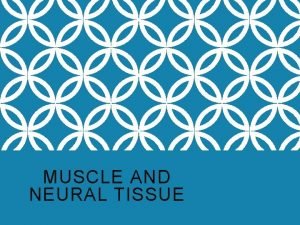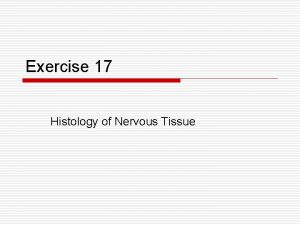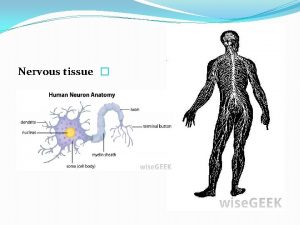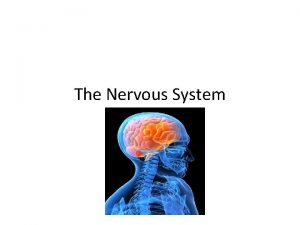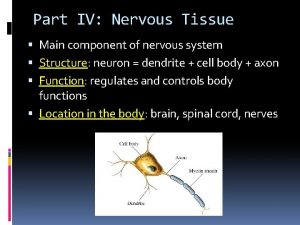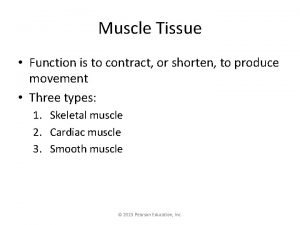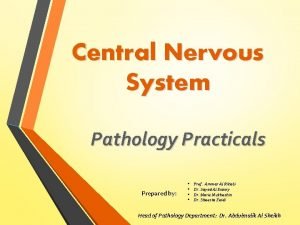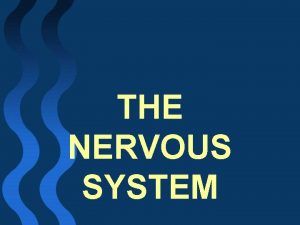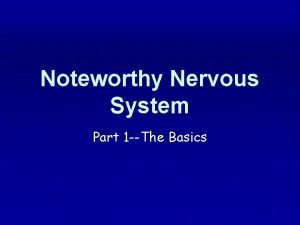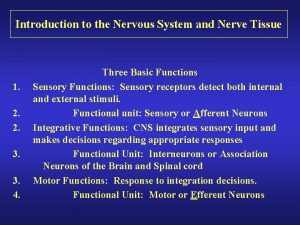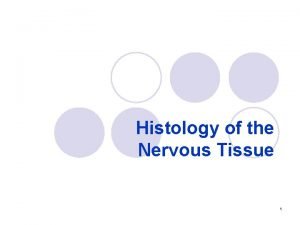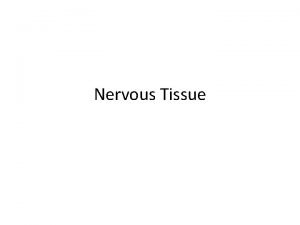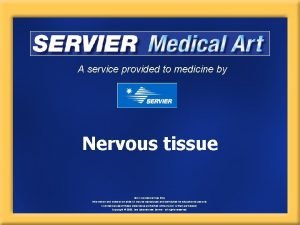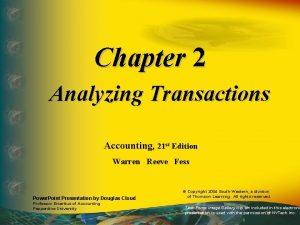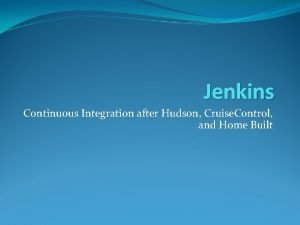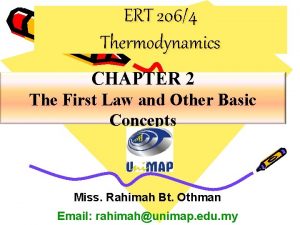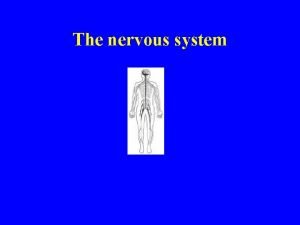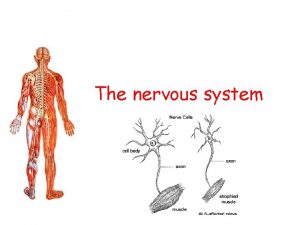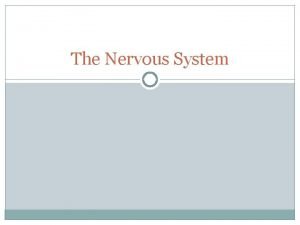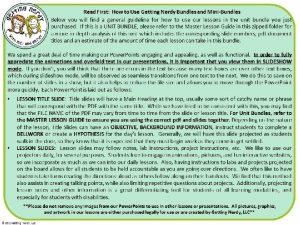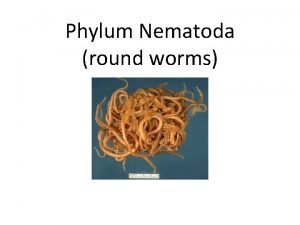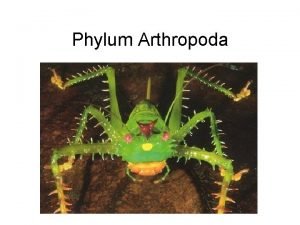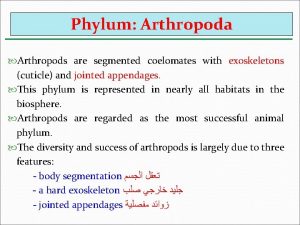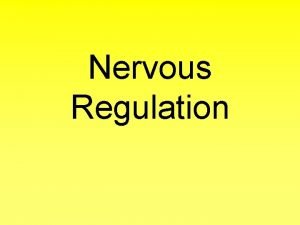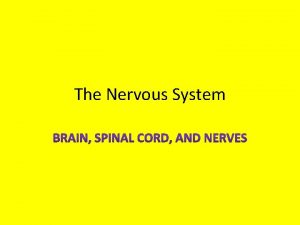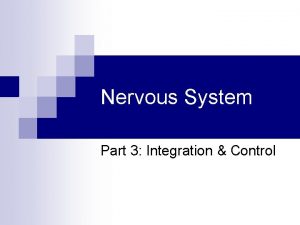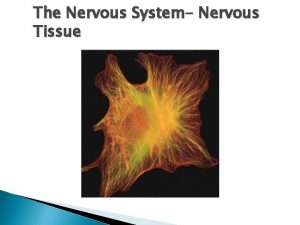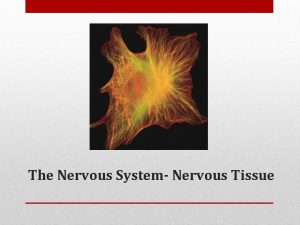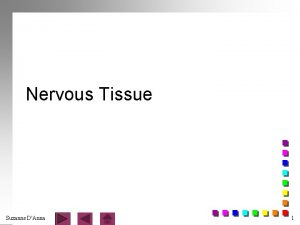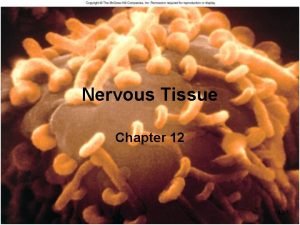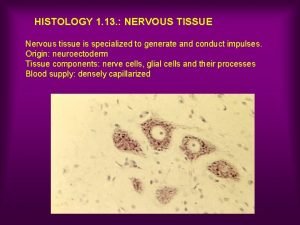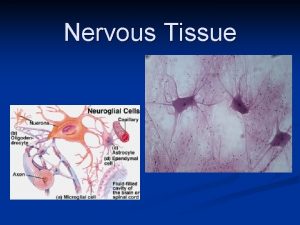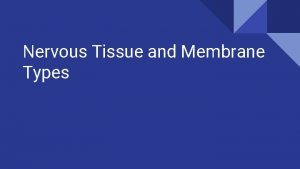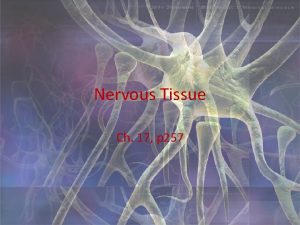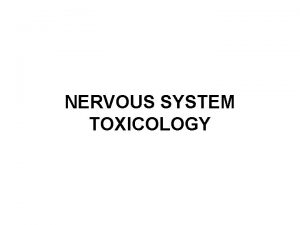Nervous System Part 3 Integration Control Nervous Tissue


































































- Slides: 66

Nervous System Part 3: Integration & Control

Nervous Tissue One of the 4 basic tissue types in the human body. n 4 Functions: Known as the 4 C’s n ¨ Communicates ¨ Commands ¨ Controls ¨ Coordinates

Types of Nervous Tissue Functions n Communication: Occurs through action potentials. ¨ n n n Action potentials: Electrical impulses triggered by ion flux. Sensory Functions: Conveying information from external and internal stimuli to the CNS via afferent neurons. Integrative Functions: Analyzing & storing sensory information; deciding on appropriate responses via interneurons. Motor Functions: Responding to integrative decisions by carrying impulses from the CNS to the effectors in the organs via efferent neurons.

Divisions of the Nervous System Central Nervous System: Consists of the brain and spinal cord. n Peripheral Nervous System: Consists of all nervous tissue outside the brain & spinal cord – 2 subdivisions: n ¨ Autonomic Nervous System (ANS) n Sympathetic Nervous System n Parasympathetic Nervous System n Enteric Nervous System ¨ Somatic Nervous System (SNS)


Central Nervous System (CNS) n Structures: ¨ Brain ¨ Spinal n Corn Both will be talked about in detail in Chapter 11!


Peripheral Nervous System (PNS) Consists of all nervous tissue located outside of the CNS. n Includes Ganglia, which are small masses of nervous tissue. n Subdivisions: n ¨ Autonomic Nervous System (ANS) n Sympathetic Nervous System n Parasympathetic Nervous System n Enteric Nervous System ¨ Somatic Nervous System (SNS)


Autonomic Nervous System (ANS) Consists of sensory neurons that pass information from the autonomic sensory receptors in the visceral organs & motor neurons to the CNS and back. n 2 Major Branches: n ¨ Sympathetic Nervous System: Triggers fight -or-flight response. ¨ Parasympathetic Nervous System: Returns body to homeostasis when threat has passed.

Enteric Nervous System (ENS) Considered a “small brain” since it has so many neurons. n Some debate about its classification is still continuing. Right now it is classified as a subdivision of the peripheral nervous system, but receives most of its innervations from the autonomic nervous system so is also classified as a subdivision of the ANS. n

Somatic Nervous System (SNS) n Consists of the… ¨ Sensory neurons passing information from receptors to the sensory areas of the CNS ¨ Motor neurons passing impulses from the SNS to the skeletal muscles.

Types of Neurons n 3 Basic Types of Neurons: ¨ Sensory Neurons aka Afferent Neurons: Detect stimuli & carry impulses from the cranial or spinal nerves to the CNS. ¨ Motor Neurons aka Efferent Neurons: Carry impulses away from the CNS from the brain to the spinal cord and PNS. ¨ Interneurons aka Association Neurons: Located inside the CNS and perform nervous system integrative functions.


Properties of Neurons n Properties shared by all neurons: ¨ Excitability: Ability to respond to stimuli & changes in the environment that excites a sensory receptor, neuron, or muscle fiber. ¨ Conductivity: The ability to produce and respond to electrical signals to aid in communication. ¨ Secrete: The ability to secrete chemical neurotransmitters to aid in communication.

The Nerve Cell n 3 Basic Parts: ¨ Dendrites ¨ Soma ¨ Axon

The Nerve Cell n Dendrites: Consists of many branches coming out of the soma of the cell. ¨ Function to receive information from the synaptic clef. ¨ Process: Fibers that run to dendrites and from axons.

The Nerve Cell n Soma: The cell body consisting of a central nucleus surrounded by cytoplasm & containing standard organelles. ¨ Nissl Bodies: Clusters of endoplasmic reticulum found in the soma.

The Nerve Cell n Axon: The long, single-stranded portion of the neuron exiting from the opposite end of the soma from the dendrites. ¨ Functions to transmit information to the synaptic clef. ¨ Axon Hillock: The point of connection between the axon to the soma. ¨ Axon Terminals: The tiny branches dividing off at the end of the axons. ¨ Axoplasm: The cytoplasm of the axon.

The Nerve Cell n Myelin Sheath: Thin layer of fat cells around the axon that greatly increases the speed of neural transmission. ¨ Produced by Schwann Cells and Oligodendrocytes. ¨ Nodes of Ranvier: Gaps in the myelin sheath that occur at regular intervals to help impulses “skip” between sections & therefore travel faster. n Salutatory Conduction: The process of signals “skipping” across the nodes of Ranvier to increase transmission speed.


Classification of Neurons n Based on myelin: ¨ Myelinated: Neurons that have a myelin sheath. ¨ Unmyelinated: Neurons that do not have a myelin sheath. n Based on number of axons & dendrites: ¨ Multipolar: Neurons that have a single axon and several dendrites – the most common! ¨ Bipolar: Neurons with a single axon and single dendrite – found in the eye, inner ear, and olfactory region of the brain. ¨ Unipolar: Neurons where the axon and dendrite have fused into a single process (axon) that branches in two directions. Primarily serves as a sensory neuron.

Types of Matter n Gray Matter: Contains mainly nerve cell bodies and unmyelinated fibers. ¨ Found in the outer layer of the brain. ¨ Found in the inner layer of the spinal cord. n White Matter: Contains mainly myelinated axons and appears to be white. ¨ Found on the inside of the brain. ¨ Found on in the outer later of the spinal cord. Cerebeluum


Synapses Synapse: The point at which one neuron communicates with another. n Synaptic Cleft: The slight gap between two neurons where the synapse occurs. n Presynaptic Neuron: The neuron transmitting the signal through its axon. n Postsynaptic Neuron: The neuron receiving the signal through its dendrites. n


Synapses n n Two types of synapses exist, named for their method of communication transmission. Electrical Synapses: Electrical signals are directly transmitted between cells. ¨ Gap Junctions convey electrical signals directly between adjacent cells. ¨ Provide faster communication & can be produced in unison by a large number of neurons & muscle fibers. ¨ More common in smooth muscle, cardiac muscle, and in embryos.

Synapses n Chemical Synapses: Membranes do not touch, so signals do not pass directly. ¨ Cells respond to neurotransmitters released from synaptic knobs into the synaptic cleft binding to receptor sites. ¨ Steps: n n The presynaptic cell translates the electrical impulse into a chemical signal. The postsynaptic cell translates the chemical signal back into an electrical impulse. ¨ Steps cause a synaptic delay close to 0. 5 microseconds.

Neuraglia n Neuroglia: Support cells of the nervous system. ¨ n Cells smaller than neurons and outnumbering them 50 to 1. They do not generate impulses but can divide & multiply. Types of Neuroglia: ¨ Schwann Cells: Cells located in the PNS that produce myelin. n Neurolemma aka Sheath of Schwann: Outer cytoplasmic layer of the Schwann cells containing its own nucleus. Oligodendrocytes: Cells located in the CNS that produce myelin. ¨ Astrocytes: Star-shaped cells that. . . ¨ n n Provide nutrients Help regulate the chemical environment Absorb excess neurotransmitters Assist in forming the blood-brain barrier

Neuroglia n Types of Neuroglia: ¨ Microglia: Macrophage cells that act as an immune response to protect the CNS from disease. ¨ Ependymal Cells: Cells that line the brain. n Help circulate the cerebrospinal fluid in the CNS using cilia on the outside of the cells. ¨ Satellite the PNS. Cells: Help support the other cells of

Electrophysiology Electrical Potential: The gradient difference in the concentration of charged particles between points. n Polarized: The term used to describe cells that have an electrical potential. n Depolarized: The term used to describe cells that do not have an electrical potential. n

Electrophysiology n Membrane Potential: The potential electrical voltage difference stored in the resting membrane. ¨ Works n the same way a car battery does! Resting Membrane Potential: The amount of electrical charge built up as a result of…. ¨ Negative ions lined up along the inside of the cell membrane ¨ Positive ions lined up along the outside of the ¨ Potassium (K+) ions leaking outward at a faster rate than Sodium (Na+) ions permeating inward n Resting Membrane Potential of a polarized neuron is -70 m. V (minivolts).

Neural Communication Neurons communicate through action potentials brought on by polarization & depolarization. n Ion Channels: Channels in the cell membrane that allow ions to move in and out of the cell to create the resting membrane potential. n ¨ Gates: The method of controlling ion passage.

Neural Communication n 4 Types of Ion Channels: ¨ Leakage Channels: Gates open and close randomly – regulated by normal permeability. ¨ Voltage-Gated Channels: Open in response to a change in the membrane potential. n Voltage-gated sodium channels are blocked with local anesthetics, which prevents the pain signal from reaching the CNS. ¨ Ligand-Gated Channels: Open and close in response to chemical stimuli – primarily regulated by neurotransmitters and hormones. ¨ Mechanically Gated Channels: Open and close in response to outside mechanical stimulation. n Example: Auditory receptors in the ears stimulated by sound waves or physical pressure.

Neural Communication n Local Potential or Graded Potential: Occurs when only a small deviation is found in the resting potential. ¨ Only occurs due to the opening of a ligandgated or mechanically-gated channel. ¨ Potentials vary in size, are only effective for a short distance, and can be excitatory, inhibitory, & reversible.

Action Potentials n Action Potentials aka Impulses: Generated along voltage-gated ion channels. ¨ Consist of rapid changes in membrane voltage. ¨ Triggered by depolarization of the cellular membrane.

Action Potentials Stimuli triggers the start of the neural process. n Depolarization occurs as the resting membrane voltage changes toward threshold level. n Threshold is reached when the voltage rises enough to open the voltage-gated ion channels. n ¨ Typically neurons. occurs at -55 m. V (minivolts) in

Action Potentials n Gates Open: ¨ Sodium Gates open quickly, allowing an inrush of sodium ions. ¨ Potassium Gates open slowly, causing a trickle of potassium ions into the cell. n Sodium Influx only lasts a few 10, 000’s of a second and causes: ¨ Membrane to reach +30 m. V (minivolts) ¨ Sodium gates to close ¨ Potassium gates to fully open n Repolarization occurs as the potassium levels rapidly drop, causing the voltage to drop back to -55 m. V (minivolts).

Action Potentials n n n Refractory Period: The amount of time necessary for the cell to return to its resting state via repolarization. Absolute Refractory Period: The period when the repolarization is less than one-third complete and cannot generate another action potential, no mater what stimuli occur. Relative Refractory Period: Once repolarization is one-third complete, stimuli considerably stronger than the threshold stimulus can produce an action potential.

Action Potentials n All-Or-Nothing Law: An action potential will occur once the voltage level reaches threshold, no matter what. ¨ It will always be the same size ¨ The signal will always travel down the entire length of the neuron ¨ The action potential will not fire until it reaches threshold, and will always fire once it does.


Methods of Conduction Continuous Conduction: When an impulse travels around 2 m/sec (meters per second) down an unmyelinated neuron. n Saltatory Conduction: When an impulse travels around 120 m/sec down a myelinated neuron. n ¨ The impulse “jumps” from new action potentials generated at each node of Ranvier.

Neurotransmitters n Neurotransmitters: Chemical signals transmitted and interpreted by the nervous system. ¨ Neuroreceptors: Sites located on the postsynaptic neuron that binds to neurotransmitters. n Binding causes an influx of Sodium (Na+) which depolarizes the neuron and fires of an action potential. ¨ Synaptic Vesicles: Sacs on the knobs on the end of the axons that are used to store neurotransmitters.

Neural Integration n Excitatory Postsynaptic Potential (EPSP) aka Excitatory Neurotransmitters: Brings the charge closer to threshold being reached by depolarizing the membrane. ¨ The larger the number of EPSPs the higher the change that the threshold will be reached. ¨ Effect of EPSPs must be grater than the effect of the IPSPs. n Inhibitory Postsynaptic Potential (IPSP) aka Inhibitory Neurotransmitters: Takes the charge farther away from threshold by hyperpolarizing the membrane.

Neural Integration n Summation: The process of a neuron integrating the information from thousands of synapses providing incoming information at a time. ¨ n Trigger Zone: The point of reception for the summation of incoming signals. Two forms of summation: Temporal Summation: A single presynaptic neuron generates enough EPSPs in short intervals, allowing signals to build up before the first ones decay. ¨ Spatial Summation: EPSPs from several different postsynaptic neurons are added up to reach the threshold. ¨ n n Facilitation: When neurons enhance the effects of other neurons. Inhibition: When neurons inhibit or suppress the effects of other neurons.

Neurotransmitters n Over 100 neurotransmitters found in the body & categorized into 3 basic categories of small-molecule neurotransmitters: ¨ Acetylcholine ¨ Amino acids ¨ Biogenic amines

Acetylcholine ACh is the most studied neurtransmitter n Acts as an excitatory or inhibitory neurotransmitter depending on the synapse it is in. n Ionotropif Effect: ACh binding to ligandgated channels causes enough of a local action potential to fire the neuron. n Acetylcholinesterase (ACh. E): A second neurotransmitter released to deactivate Ach when it is no longer needed. n

Amino Acids Act as neurotransmitters in the CNS. n Two important amino acids: n ¨ Glutamate: n Excitatory neurotransmitter. Excitotoxisity: Occurs when too high a level of glutamate is present in the NS – leads to neural death. Due to lack of oxygen or inadequate blood supply. ¨ Seen in stroke victims. ¨ ¨ Aspartate: Another excitatory neurotransmitter linked to glutamate.

Biogenic Amines n n Modified amino acids that are both excitatory & inhibitory. Catecholamine: An amino acid with a catechol ring (6 carbons and 2 hydroxyl groups). ¨ n Biogenic amines are typically made of these. This category includes: Norepinephrine: Catecholamine responsible for arousal, dreaming & mood. ¨ Dopamine: Catecholamine that contributes to emotions, addictive behaviors, pleasures, & muscle tone. ¨ Serotonin: NOT a catecholamine – involved in sensory perception, mood control, appetite, temperature regulation, and sleep. ¨

Prozac Nation Selective Serotonin Reuptake Inhibiter (SSRI): Stops the uptake of the neurotransmitter serotonin & increases the “good mood” by allowing the serotonin to stick around the synapse longer. n Prozac! n

Neuropeptides Neuropeptide: A string of 3 -40 amino acids linked by peptide bonds that function as neurotransmitters. n These include: n ¨ Enkephalins: Have a pain relieving effect 200 times as strong as morphone. ¨ Endorphins: Block pain and play a role in emotions, sexual activity, and memory. ¨ Dynorphins: Block pain and play a role in emotions, sexual activity, and memory.

Neuromodulators n Neuromodulators: Neuropeptides, hormones, or chemicals that alter synaptic transmission. ¨ Work by raising or lowering the number of receptors or altering the production, release, & reuptake of neurotransmitters.

Neuromodulators n Examples: ¨ Drugs that stimulate or inhibit neurotransmitter synthesis. n ¨ L-Dopa increases dopamine production & is used for Parkinson’s disease. Drugs or toxins that increase or decrease the release of neurotransmittesr n n Amphetamines increase the release of dopamine and norepimepherine to increase energy. Botulinum toxin blocks the acetycholine release from motor neurons resulting in paralysis. Agonists: Agents that activate neurotransmitter receptors. ¨ Antagonists: Agents that block neurotransmitter receptors. ¨ Agents that increase or decrease the removal of neurotransmitters. ¨ n Selective Serotonin Reuptake Inhibitors (SSRIs) for depression

Neural Circuits: Complex networks of billions of neurons that are processing a specific kind of information. n Labeled according to arrangement & branching of the neurons. n

Types of Neural Circuits n Simple Series Circuits: Consist of one presynaptic neuron stimulating only one postsynaptic neuron. ¨ Neurons form a chain of communication.

Types of Neural Circuits n Diverging Circuits: One presynaptic nerve sends impulses to an increasing number of postsynaptic nerves along the circuit. ¨ Example: The relatively small number of neurons in the brain that diverge to serve the large number of neurons in the spinal cord & beyond.

Types of Neural Circuits n Converging Circuits: One postsynaptic neuron receives signals from several sources. ¨ Example: A single motor neuron that receives input from several brain pathways.

Types of Neural Circuits n Reverberating Circuits: Send impulses in cycles & repeatedly through the circuit. ¨ Presynaptic neuron is stimulated ¨ Postsynaptic neuron fires a series of signals ¨ Example: Breathing is stimulated by a series of signals to contract and relax the diaphragm muscles.

Types of Neural Circuits n Parallel After-Discharge Circuits: One presynaptic cell stimulates a group of neurons, which then converge upon one common postsynaptic cell. ¨ Results: The postsynaptic cell receives a series of impulses in rapid succession & reaches threshold faster.

Synaptic Plasticity n Synaptic Plasticity: The ability of neurons to create new synapses or modify existing ones. ¨ Allows the brain to change with experience. ¨ New dendrites can grow ¨ New proteins can form ¨ Synapses between neurons can change. n This is critical to neural repair and memory!

Neuron Injury & Repair n Injury of a neuron can occur due to… Hypoxia: Lack of oxygen ¨ Trauma: Physical injury or bruising due to head injury. ¨ Burns: 3 rd degree burns will destroy the sensory neurons in the area! ¨ n Neurogenesis: The development of neurons from undifferentiated stem cells. DOES NOT OCCUR IN ADULTS! ¨ n Neurons do not undergo mitosis past adolescence! Fortunately the brain is highly adaptive! ¨ Unused or underused areas of the brain will take over the jobs of areas that are damaged or destroyed. It may take a while, but it is possible to regain the functions lost to brain damage due to synaptic plasticity!

Memory Engram: The neural pathway through which memories are traced. n Types of Memory: n ¨ Immediate Memory ¨ Short-Term Memory ¨ Long-Term Memory

Immediate Memory n Immediate memory only lasts for a few seconds. ¨ Does not become stored as permanent memory without utilizing a learning technique such as rehearsal. ¨ Only VERY small amounts of information can be stored.

Short-Term Memory n Short-Term memory aka Working Memory only lasts for a for several seconds to several hours. ¨ LIMITED capacity controlled by Miller’s Magic Number ¨ Miller’s Magic Number: 7+/-2 This means we can only hold between 5 and 9 (average of 7) pieces of information in short-term memory at a time. n This can be numbers, letters, objects, or short sentences. n

Long-Term Memory n Long-term memory can last a lifetime, but may become difficult to retrieve, or bring back to conscious thought. ¨ Practically n unlimited capacity. Two types of long-term memory: ¨ Declarative Memory: Memories formed of events and facts. n Who, what, when & where. ¨ Procedural n How-to! Memory: The ability to retain skills.

Multiple Sclerosis (MS) n Multiple Sclerosis (MS): An autoimmune disease that causes marked degeneration of the myelin sheaths in the CNS. ¨ Symptoms: Progressive loss of nerve control. ¨ Approximately 2 million affected worldwide.
 Neural circuits the organization of neuronal pools
Neural circuits the organization of neuronal pools Sensory input and motor output
Sensory input and motor output Nerve cell processes
Nerve cell processes What does this graph show
What does this graph show Medulla oblongata function
Medulla oblongata function What are the characteristics of nervous tissue
What are the characteristics of nervous tissue Histology of nervous tissue ppt
Histology of nervous tissue ppt Sheeps brain
Sheeps brain Classify nervous tissue
Classify nervous tissue Nervous tissue in the lungs
Nervous tissue in the lungs Nervous tissue
Nervous tissue Nervous tissue
Nervous tissue Nervous tissue in brain
Nervous tissue in brain Nervous tissue in brain
Nervous tissue in brain Nervous tissue
Nervous tissue Diagram of nervous tissue
Diagram of nervous tissue Nervous tissue
Nervous tissue Nervous tissue
Nervous tissue Diagram of nervous tissue
Diagram of nervous tissue Nervous tissue definition
Nervous tissue definition Unipolar neurons are found in
Unipolar neurons are found in Nervous tissue
Nervous tissue How is aerolar tissue different than aerenchyma tissue?
How is aerolar tissue different than aerenchyma tissue? Nervous system and digestive system
Nervous system and digestive system Endocrine system and nervous system
Endocrine system and nervous system General mechanism of hormone action
General mechanism of hormone action Endocrine system
Endocrine system Three dimensions of corporate strategy
Three dimensions of corporate strategy Make or buy continuum
Make or buy continuum Simultaneous integration example
Simultaneous integration example 1. part one—analyzing accounting concepts and procedures
1. part one—analyzing accounting concepts and procedures Part two analyzing transactions in a cash control system
Part two analyzing transactions in a cash control system Example of source integration
Example of source integration 3 part source integration
3 part source integration Cruise control continuous integration
Cruise control continuous integration Cruise control ci
Cruise control ci Part whole model subtraction
Part whole model subtraction Part to part ratio definition
Part to part ratio definition Brainpop ratios
Brainpop ratios Technical description
Technical description Under bar parts
Under bar parts The phase of the moon you see depends on ______.
The phase of the moon you see depends on ______. 미니탭 gage r&r 해석
미니탭 gage r&r 해석 Control mass in thermodynamics
Control mass in thermodynamics Chemical messengers of the nervous system
Chemical messengers of the nervous system Platyhelminthes
Platyhelminthes The nervous system is made up of
The nervous system is made up of Three basic functions of the nervous system
Three basic functions of the nervous system Learning objectives of nervous system
Learning objectives of nervous system Bipolar neuron function
Bipolar neuron function What is stimuli in nervous system
What is stimuli in nervous system Nervous system objectives
Nervous system objectives Craniosacral region
Craniosacral region Parasympathetic nervous system def
Parasympathetic nervous system def Spinal nerve pairs
Spinal nerve pairs Sns pg
Sns pg The nervous system brain scienstructable
The nervous system brain scienstructable Autonomic nervous system muscles
Autonomic nervous system muscles Phylum
Phylum Phylum arthropoda marine
Phylum arthropoda marine Chelicerates antennae
Chelicerates antennae Nervous system of arthropods
Nervous system of arthropods Division of nervous system
Division of nervous system Parasympathatic nervous system
Parasympathatic nervous system Coelenterata nervous system
Coelenterata nervous system Autonomic nervous system consists of
Autonomic nervous system consists of Differences between nervous system and endocrine
Differences between nervous system and endocrine





